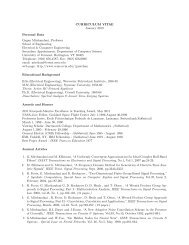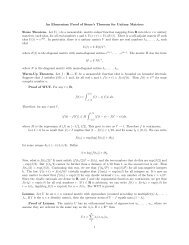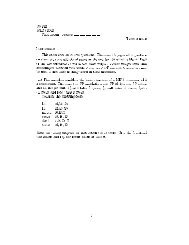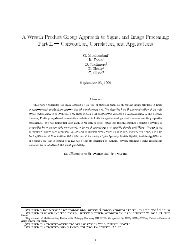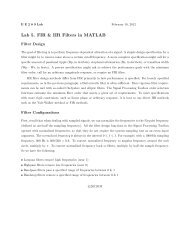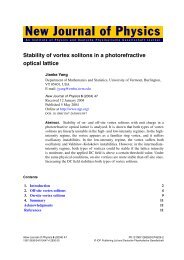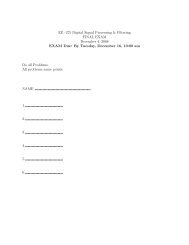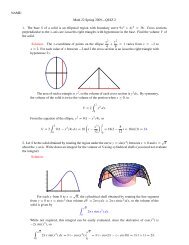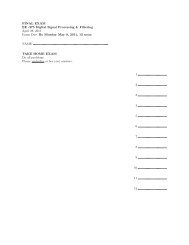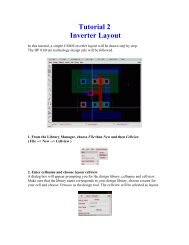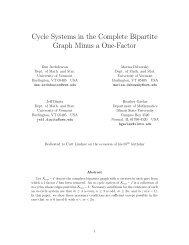Weighted inequalities for gradients on non-smooth domains ...
Weighted inequalities for gradients on non-smooth domains ...
Weighted inequalities for gradients on non-smooth domains ...
You also want an ePaper? Increase the reach of your titles
YUMPU automatically turns print PDFs into web optimized ePapers that Google loves.
The Dirichlet problem <str<strong>on</strong>g>for</str<strong>on</strong>g> the operator L is solvable <strong>on</strong> bounded Lipschitz <strong>domains</strong> Ω, andthe soluti<strong>on</strong> is written in terms of elliptic measure ω L . Un<str<strong>on</strong>g>for</str<strong>on</strong>g>tunately, this measure need not beA ∞ with respect to surface measure <strong>on</strong> ∂Ω—but it is doubling. It also has a Green’s functi<strong>on</strong>, G L ,which satisfies estimates (relative to ω L ) analogous to those that hold <str<strong>on</strong>g>for</str<strong>on</strong>g> G and ω. Indeed, theproofs we have given c<strong>on</strong>cerning weighted norm <str<strong>on</strong>g>inequalities</str<strong>on</strong>g> of the <str<strong>on</strong>g>for</str<strong>on</strong>g>m(∫ ) 1/q (∫|∇u| q dµ ≤ |f| p vdωΩ δ ∂Ω(where u is f’s harm<strong>on</strong>ic extensi<strong>on</strong>, and ω is harm<strong>on</strong>ic measure <str<strong>on</strong>g>for</str<strong>on</strong>g> the Laplacian), will go throughalmost verbatim <str<strong>on</strong>g>for</str<strong>on</strong>g> weighted norm <str<strong>on</strong>g>inequalities</str<strong>on</strong>g> of the <str<strong>on</strong>g>for</str<strong>on</strong>g>m) 1/p(∫ ) 1/q (∫) 1/p|∇u| q dµ ≤ |f| p vdω LΩ δ ∂Ωwhere u is now f’s elliptic extensi<strong>on</strong>. The <strong>on</strong>e difficulty is that ∇u need not be defined pointwise.This requires us to rephrase our weighted norm inequality somewhat, and to look carefully at theproof of <strong>on</strong>e of the auxiliary results used in the proof of Theorem 3.1.Let us assume that we have our family of boundary cubes G, as used in the proof of Theorem3.1. In that proof we used the fact that, <str<strong>on</strong>g>for</str<strong>on</strong>g> every Q b ∈G,sup T (Qb )) |∇u| was “morally equivalent”tosup l(Q b ) −1 |u(X) − u(Y )| (3.8)X,Y ∈T (Q b )when u was harm<strong>on</strong>ic. In our rephrased <str<strong>on</strong>g>for</str<strong>on</strong>g>m of Theorem 3.1, we will essentially replace |∇u| withthe right-hand side of (3.8).Let G be a family of boundary cubes as described above. Let {X Qb } and {Y Qb } be two familiesof points in Ω, both indexed over G, such that, <str<strong>on</strong>g>for</str<strong>on</strong>g> all Q b ∈G, X Qb ∈ T (Q b )andY Qb ∈ T (Q b ). Weshall call such a double sequence hyperbolically close.Theorem 3.2. Let Ω ⊂ R d+1 be a bounded Lipschitz domain, and let ω L be elliptic measure <strong>on</strong>∂Ω <str<strong>on</strong>g>for</str<strong>on</strong>g> some fixed point X 0 ∈ Ω. LetG be a familyof boundarycubes as described above. Supposethat v ∈ L 1 (∂Ω,dω L ) is a n<strong>on</strong>-negative functi<strong>on</strong> and µ is a positive Borel measure <strong>on</strong> Ω. Defineσ ≡ v 1−p′ , and suppose that σdω L ∈ A ∞ (ω L ) <strong>on</strong> ∂Ω. If1



